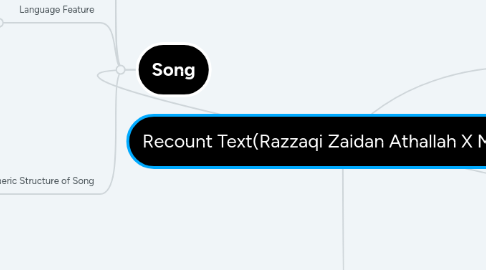
1. Definition: Recount text is a type of text in English that tells about a story, action, or activity. Usually, recount text tells about someone's experience. The purpose of the recount text is to entertain the reader, so that there is no conflict in this text. In addition, this text also aims to provide information to readers.
2. Song
2.1. Definition: Song is a composition of tone or voice in sequence, combination and temporal relation to produse a musical compositian that has unity and continuity.
2.2. Purpose: Songs are used to express feeling and idea in an entertaining world. Songs can be used to deliver social criticism. The moral values are hidden in the lyrics.
2.3. Language Feature
2.3.1. Metaphor: comparing what nothing that is not aliketosuggestthattheyactuallyhavesomething in common. At first glance, the two things being compared are not related, but in fact there are similarities between the two things.e.g. "Time is a thief" or "Herhaisrwassilk"
2.3.2. Simile: Comparestwothingsusing "like" or "as". A thing is described in a similar way by using the words 'like' or 'as' e.g. "My loveislike a redrose".
2.3.3. Hyperbole: a dramatic language. Big exaggeration, usually with humor. A thing is described in exaggeration, sometimes tickling because it is too much. e.g. "Thatmathhomeworktookme 8 millionyearstofinish".
2.3.4. Personification: Anobjectappearlike a person. Objects (non-humans) have human-like abilities.e.g. "The windwhisper" or "The snowflakesdanced in thewind".
2.3.5. Allitration: Therepetationofthesamebeginningsound in a series of words. Repeating the sound of the sound at the beginning of each word. e.g. "Peter Parker picks a pack ofpantspunctually"
2.4. Generic Structure of Song
2.4.1. Intro: Which is the beginning of the song, usually the singer's voice cannot be heard (only the instruments)
2.4.2. Verse or stanza: Is the introduction to the chorus.
2.4.3. Refrain: Transition from verse to chorus
2.4.4. Chorus: The core part, is usually the easiest to remember.
2.4.5. Bridge: Connecting the chorus to the next chorus or to the coda.
2.4.6. Coda: The ending of the song.
3. Narrative Text - Legend
3.1. Definition: Narrative Text is a type of text that tells an imaginary / fictional story with the aim of entertaining in a chronologically interrelated manner.
3.2. Generic Structure of Narrative Text
3.2.1. Orientation: Orientation or so-called introduction, contains about who, when, where a story is set.
3.2.2. Complication: The problem parts of the story begin to develop. (Problems start to emerge or start to occur and begin to develop)
3.2.3. Resolution: The problem parts of the story begin to be resolved. The problem is resolved, either in a happy "happy ending" or a "bad ending" or bad.
3.2.4. Coda / reorientation (optional): A section that describes the lessons that can be learned from the story.
3.3. Language Feature
3.3.1. Past tense: (Killed, drunk, went, won, sent, etc) (killed, drunk, left, won, sent, etc.).
3.3.2. Adverb of time: (Once upon a time, today, one day, will, yesterday, later, etc) (At any time, today, one day, will, yesterday, later, etc.).
3.3.3. Time conjunction: (When, then, suddenly, before, after, until, a soon as, etc) (when, then, suddenly, before, after, arrived, immediately, etc.).
3.3.4. Specific characters / use of specific story characters, not general ones. (Cinderella, Alibaba, Snow White, Tangled, Ariel, etc.)
3.3.5. Action verbs / verbs that indicate an action: (Killed, walked, wrote, stayed, dug, etc) (killed, walked, wrote, stayed, dug up, etc.)
3.3.6. Read out a live speech to make the story come alive (Direct speech). (Princess said, "My name is Princess) (Princess said," My name is Princess). Live speech using the present tense.
3.3.7. Saying and thinking verb: A verb that denotes utterance or reporting. (Said, told, thought, etc) (said, told a story, thought, etc.).

